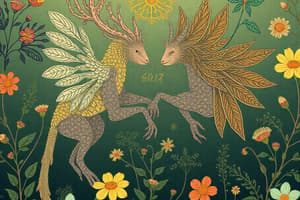Podcast
Questions and Answers
In a forest ecosystem, how does the concept of an ecological niche contribute to the coexistence of multiple species?
In a forest ecosystem, how does the concept of an ecological niche contribute to the coexistence of multiple species?
- It encourages species to develop identical survival strategies for maximum efficiency.
- It forces weaker species to migrate to new habitats, reducing competition.
- It promotes direct competition for resources, leading to the survival of the fittest.
- It allows species to minimize competition by utilizing different resources and habitats. (correct)
If two species interact in such a way that one benefits while the other is neither harmed nor helped, what type of ecological relationship is this?
If two species interact in such a way that one benefits while the other is neither harmed nor helped, what type of ecological relationship is this?
- Competition
- Neutralism
- Mutualism
- Commensalism (correct)
An ecologist observes that different species of warblers in a forest feed at different heights within the same trees. Which ecological principle does this observation best support?
An ecologist observes that different species of warblers in a forest feed at different heights within the same trees. Which ecological principle does this observation best support?
- Resource partitioning, where species utilize different parts of the resource to reduce competition. (correct)
- Succession, where species gradually replace each other over time.
- Competitive exclusion, where one species dominates the resource.
- Character displacement, where species evolve to have identical traits.
How does the interaction between flowering plants and pollinating insects exemplify mutualism?
How does the interaction between flowering plants and pollinating insects exemplify mutualism?
In a scenario where two different species of bacteria coexist in a test tube without affecting each other's growth or survival, what type of interaction is being displayed?
In a scenario where two different species of bacteria coexist in a test tube without affecting each other's growth or survival, what type of interaction is being displayed?
Flashcards
Plant-Insect Mutualism
Plant-Insect Mutualism
Interaction where plants benefit from insects pollinating them, while insects get food from the flowers.
Neutralism
Neutralism
Interaction where different species neither harm nor benefit each other.
Commensalism
Commensalism
One species benefits, while the other is neither harmed nor helped.
Ecological Niche
Ecological Niche
Signup and view all the flashcards
Niche Partitioning
Niche Partitioning
Signup and view all the flashcards
Study Notes
- Plants with flowers have relationships with animals.
- Insects get food from flowers, and flowers are pollinated by insects.
Neutralism
- Individuals of different species interact without harm or benefit to each other.
Commensalism
- One species benefits, while the other is unharmed.
Ecological Niche
-
Competition is less between different species than within the same species.
-
Each plant or animal prefers different food, has different enemies, and needs different living spaces.
-
Ecological niche: the role of an organism in its habitat
-
Examples of niche elements: food, shelter, predator avoidance, tolerance to ecological factors.
-
In forests, species avoid competition by occupying different ecological niches.
-
Species can live near each other without competing, and no species forces another to leave.
-
The foraging height, in feet, is shown for different types of warblers.
-
Warblers include:
- Blackburnian warbler
- Cape May warbler
- Black-throated green warbler
- Bay-breasted warbler
- Myrtle warbler
Studying That Suits You
Use AI to generate personalized quizzes and flashcards to suit your learning preferences.




